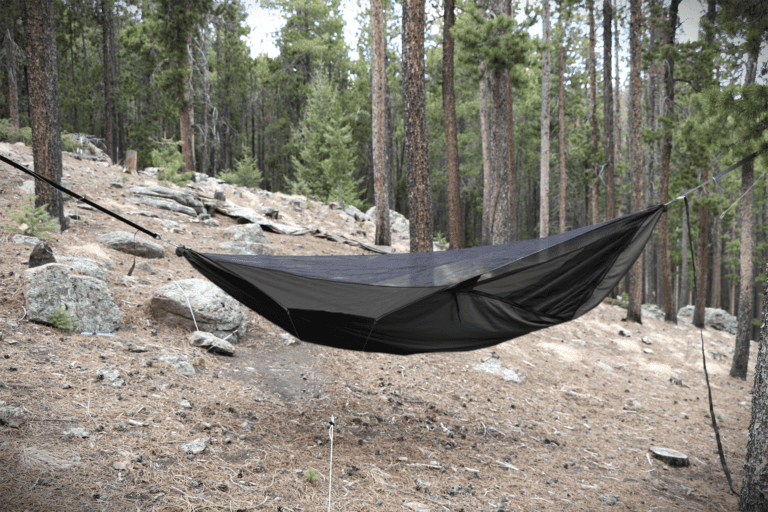Table of contents
Introduction
Warbonnet hammocks are renowned for their exceptional quality, making Warbonnet hammock maintenance essential for long-term use:
- Durability
- Comfort
- Exceptional design
These attributes make them a favorite among outdoor enthusiasts and seasoned hikers alike. Whether you’re relaxing in your backyard or embarking on a multi-day camping trip, proper Warbonnet hammock maintenance ensures reliable performance and extends the life of your investment.
Why Maintenance Matters
Caring for your hammock doesn’t have to be complicated. With:
- Regular cleaning
- Proper storage
- Seasonal maintenance
you can protect your hammock from wear and tear and keep it in excellent condition for years to come. Discover more about Warbonnet hammocks and their exceptional features in our Ultimate Guide for Outdoor Comfort and Survival.
What This Guide Covers
This guide will walk you through:
- Spot cleaning techniques
- Seasonal care tips
- Common mistakes to avoid
Let’s dive in and discover how to keep your Warbonnet hammock in peak condition, no matter the season or terrain. Follow our expert tips to maximize the lifespan of your hammock and ensure it’s always adventure-ready.
Cleaning Your Warbonnet Hammock
Proper cleaning is an essential aspect of Warbonnet hammock maintenance. It preserves your hammock’s quality and extends its lifespan. Whether tackling everyday dirt or performing a deep clean, using the right techniques ensures your hammock remains in peak condition.
1. Regular Cleaning Routine
Maintain your hammock with these simple steps:
- Shake off debris: After each use, shake out dirt, leaves, and other debris to prevent buildup.
- Spot cleaning: Use a soft sponge or cloth with mild, biodegradable soap and lukewarm water to remove stains and dirt.
- Avoid harsh chemicals: Bleach and abrasive cleaners can weaken the fabric and damage protective coatings, so avoid them.
2. Deep Cleaning Guidelines
For a thorough clean:
- Hand washing: Fill a basin or tub with lukewarm water and a small amount of mild detergent. Submerge the hammock and gently agitate it to loosen dirt.
- Machine washing: Place the hammock in a large laundry bag and wash it on a gentle cycle with cold water. Avoid fabric softeners, as they can leave residues that affect performance.
- Rinse thoroughly: Ensure all soap is rinsed out to prevent residue buildup.
3. Drying Tips for Warbonnet Hammocks
- Air dry only: Hang the hammock in a shaded, well-ventilated area. Direct sunlight can fade colors and weaken the fabric.
- Avoid tumble drying: High heat can damage the material and compromise the hammock’s integrity.
Incorporating these cleaning techniques into your Warbonnet hammock maintenance routine will keep your hammock fresh, functional, and ready for your next adventure.
Storing Your Hammock
Proper storage is a crucial part of Warbonnet hammock maintenance, ensuring long-term performance and durability. By following these best practices, you can protect your hammock from moisture, pests, and environmental damage.
1. Proper Storage Techniques
Store your hammock safely by following these steps:
- Clean before storing: Thoroughly clean your hammock to remove dirt, sweat, and debris that could cause mold or mildew.
- Fold or roll your hammock: Choose a method that suits your storage space, keeping the hammock compact without creating hard creases.
- Use breathable storage bags: Opt for a mesh or cotton bag to prevent moisture buildup and allow proper airflow.
- Keep away from sunlight: Prolonged exposure to UV rays can degrade the fabric. Store the hammock in a cool, dry, and shaded area.
2. Seasonal Storage Tips for Warbonnet Hammocks
Tailor your storage methods to suit the season:
- Summer storage: Store your hammock in a shaded, ventilated space to reduce heat and UV exposure.
- Winter storage: Keep your hammock indoors in a dry area. Before storing, inspect for tears or weak spots to prevent further damage.
3. Protecting Suspension Straps and Hardware
- Separate storage: Remove suspension straps and hardware, storing them separately to avoid tangling or damage.
- Check for corrosion: Inspect metal parts for rust or corrosion, applying a protective coating if necessary.
- Avoid over-compression: Store straps and hardware in a way that preserves their shape and integrity.
By adopting these storage habits as part of your Warbonnet hammock maintenance routine, you’ll extend its lifespan and ensure it’s always ready for your next adventure.
Seasonal Maintenance Tips
Seasonal maintenance is an essential part of Warbonnet hammock maintenance, ensuring your hammock stays in excellent condition year-round. Adapting your care routine to seasonal changes protects your hammock from weather-related damage and extends its lifespan.
1. Summer Maintenance for Warbonnet Hammocks
Protect Against UV Damage
- Apply a fabric-safe UV protectant spray to shield the hammock from prolonged sun exposure.
- Store the hammock in a shaded area when not in use to reduce fading and material wear.
Quick-Dry Practices
- Shake off excess water after rain or dew exposure, and air dry the hammock completely to prevent mildew.
- Avoid storing a damp hammock, as moisture promotes mold and mildew growth.
Dealing with Dirt and Sand
- Regularly shake out sand, dirt, and other debris during summer trips.
- Spot clean frequently with mild soap and water to maintain cleanliness and freshness.
2. Winter Maintenance for Warbonnet Hammocks
Prevent Cold Weather Damage
- Use an underquilt or winter cover to protect the hammock during cold-weather use.
- Check for frost buildup and wipe it off promptly to avoid fabric stiffness or brittleness.
Indoor Storage
- Clean the hammock thoroughly before storing it indoors for long periods.
- Store it in a dry, cool space to prevent moisture buildup and fabric deterioration.
Inspect for Damage
- After winter use, inspect the hammock for stress points, such as frayed ropes or tears.
- Repair minor damage immediately to prevent further deterioration.
3. All-Season Best Practices
- Regularly inspect suspension straps, hardware, and fabric for wear and tear, regardless of the season.
- Apply waterproofing treatments as needed to improve resistance to rain and snow.
- Ensure all components are completely dry before storage to maintain their integrity.
By incorporating these seasonal maintenance tips into your Warbonnet hammock maintenance routine, you’ll ensure your hammock remains dependable and ready for adventure, no matter the season or weather conditions.
Prolonging Hammock Longevity
Prolonging the life of your hammock is a key aspect of Warbonnet hammock maintenance. By taking proactive care and following preventative measures, you can ensure your hammock delivers reliable comfort and performance for years to come.
1. Preventative Care Tips for Warbonnet Hammocks
Regular Inspections
- Examine your hammock after every few uses for signs of wear, such as frayed ropes, loose stitching, or weakened fabric.
- Inspect suspension straps and hardware for rust, corrosion, or damage, and address any issues promptly.
Limit Exposure to Elements
- Minimize exposure to prolonged sunlight, rain, or snow, which can weaken fabrics and encourage mold or mildew.
- Use a tarp or cover to provide extra protection during extended outdoor use.
Weight and Usage Guidelines
- Follow the manufacturer’s weight limits to prevent overstretching or tearing.
- Avoid using sharp objects or wearing shoes inside the hammock to reduce the risk of punctures or abrasions.
2. Repair and Maintenance
Minor Repairs
- Use a patch kit to fix small tears or holes, preventing further damage.
- Reinforce loose stitching with a durable thread and needle to maintain fabric integrity.
Professional Repairs
- For significant damage, consult the manufacturer or a professional gear repair service to ensure proper restoration.
3. Common Mistakes to Avoid
- Skipping Cleaning: Allowing dirt and debris to accumulate can cause gradual deterioration of the fabric.
- Improper Storage: Storing a damp hammock or using a non-breathable bag can lead to mold and mildew growth.
- Ignoring Early Damage: Address small issues, like frayed edges, promptly to prevent them from escalating.
4. Accessories to Improve Warbonnet Hammock Longevity
- Tarp Covers: Protect your hammock from rain and harmful UV exposure.
- Storage Bags: Use breathable bags specifically designed for hammocks to prevent moisture buildup.
- Suspension Upgrades: Invest in durable suspension straps and carabiners to enhance safety and longevity.
By incorporating these strategies into your Warbonnet hammock maintenance routine, you’ll maximize its lifespan and continue to enjoy the exceptional comfort and quality that Warbonnet hammocks are renowned for.
FAQs on Warbonnet Hammock Maintenance
1. How often should I clean my Warbonnet hammock?
Cleaning your hammock is a crucial aspect of Warbonnet hammock maintenance. Aim to clean it after every few uses or whenever it appears dirty. Regular upkeep helps prevent stains, odors, and wear, ultimately extending your hammock’s lifespan.
2. Can I machine wash my Warbonnet hammock?
Yes, you can machine wash your hammock. Use a gentle cycle with cold water and place the hammock in a large laundry bag to avoid tangling. Avoid using bleach and fabric softeners, as these can damage the fabric.
3. What’s the best way to remove stains from my hammock?
Spot clean stains using a soft sponge or cloth with mild, biodegradable soap and lukewarm water. Rinse thoroughly to ensure no residue remains. This simple routine is an essential part of effective Warbonnet hammock maintenance.
4. How do I prevent mold and mildew?
Ensure your hammock is completely dry before storing it. Use breathable storage bags and keep the hammock in a dry, well-ventilated area to avoid damp conditions that promote mold and mildew growth.
5. Can I leave my Warbonnet hammock outside for long periods?
Although designed for outdoor use, prolonged exposure to UV rays, rain, and snow can degrade the fabric. Use a tarp or cover for protection, or store your hammock indoors when it’s not in use.
6. How can I repair small tears or frayed areas?
For small tears, apply a hammock repair patch or tape to prevent the damage from spreading. For frayed stitching, reinforce the area using durable thread and a needle to maintain the hammock’s integrity.
7. What’s the best way to store my hammock during the off-season?
Proper off-season storage is a key component of Warbonnet hammock maintenance. Thoroughly clean your hammock, fold or roll it carefully, and place it in a breathable storage bag. Store it in a cool, dry place, away from direct sunlight and moisture.
8. Do I need special products for cleaning my hammock?
No, mild, biodegradable soap and lukewarm water are sufficient for most cleaning needs. Avoid harsh chemicals, as they can weaken the fabric and reduce its longevity.
9. What’s the weight limit for Warbonnet hammocks?
Weight limits vary by model, but most Warbonnet hammocks are rated to support up to 400 lbs. Always check the manufacturer’s specifications for your specific model to ensure safe use.
10. Can I use waterproofing spray on my hammock?
Yes, a fabric-safe waterproofing spray can enhance the hammock’s water resistance. Follow the product instructions carefully and test on a small area first. Adding this step to your Warbonnet hammock maintenance routine can improve its durability and performance.
Conclusion: Caring for Your Warbonnet Hammock
Maintaining your Warbonnet hammock doesn’t have to be complicated. By following a consistent routine of cleaning, proper storage, and seasonal care, you can protect your hammock from wear and tear and ensure it remains reliable for years of outdoor adventures. These practices are the foundation of effective Warbonnet hammock maintenance and are essential for preserving its quality over time.
Key Takeaways:
- Clean regularly: Spot clean after each use and deep clean periodically to keep your hammock fresh and functional.
- Store properly: Use breathable storage bags, ensure the hammock is dry, and keep it away from harsh environmental conditions.
- Adapt to the seasons: Shield your hammock from UV damage in summer and store it appropriately in winter to prevent moisture-related issues.
- Inspect frequently: Address minor repairs promptly to prevent further damage and maximize your hammock’s lifespan.
By integrating these Warbonnet hammock maintenance tips into your routine, you’ll extend your hammock’s lifespan while continuing to enjoy the exceptional comfort and durability Warbonnet hammocks are renowned for. With the right care, your hammock will remain adventure-ready, no matter the season or terrain.





